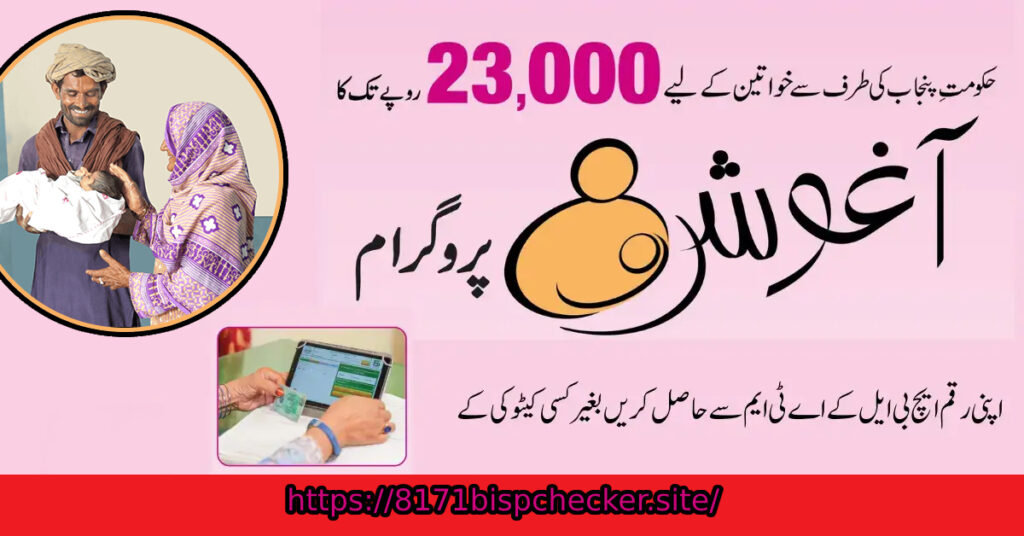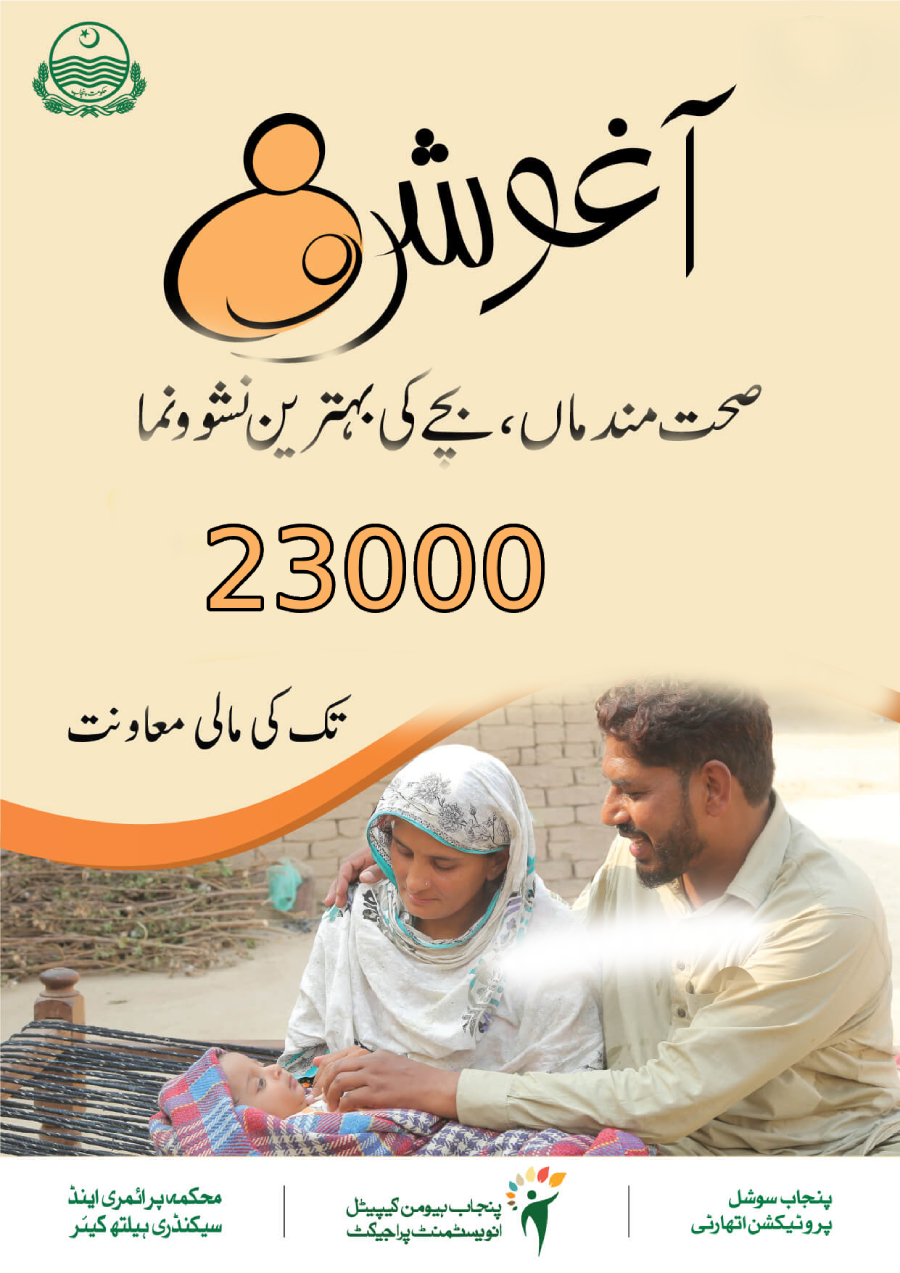Maternal and child health is the cornerstone of a healthy society and a thriving nation. Recognizing the importance of this vital sector, the Government of Punjab, under the umbrella of the Punjab Human Capital Investment Project (PHCIP), launched the Punjab Aaghosh Program. This ambitious initiative is a multi-faceted intervention designed to support pregnant and lactating women, as well as children under the age of two, in some of the most underserved districts of Punjab.
The Punjab Aaghosh Program is a transformative step aimed at reducing maternal and neonatal mortality, enhancing child development, and promoting health-seeking behaviors in rural and low-income populations. It integrates healthcare services with conditional cash transfers (CCTs) to incentivize the uptake of essential health services. This detailed article explores the Punjab Aaghosh Program’s background, objectives, eligibility, services, benefits, implementation, and its broader impact on society.
Table of Contents
- Background of the Aaghosh Program
- Goals and Objectives
- Target Beneficiaries and Districts
- Eligibility Criteria
- Services Offered under the Aaghosh Program
- Conditional Cash Transfers (CCTs)
- Implementation Mechanism
- Monitoring and Evaluation
- Achievements to Date
- Challenges and Recommendations
- Future Outlook
- Conclusion

Background of the Aaghosh Program
Pakistan has long struggled with maternal and child health indicators. According to recent statistics, maternal mortality ratio (MMR) in Pakistan stands at approximately 186 per 100,000 live births, while neonatal mortality is alarmingly high. In response, the Punjab government, supported by the World Bank, launched the Punjab Human Capital Investment Project (PHCIP) in 2020, with a key focus on improving health and nutrition outcomes.
Under this broader initiative, the Punjab Aaghosh Program was introduced as a flagship conditional cash transfer program aimed specifically at enhancing the health of mothers and their infants. The word “Aaghosh” signifies “embrace,” reflecting the program’s purpose of nurturing and protecting both mother and child during a critical period of growth.
Goals and Objectives
The Punjab Aaghosh Program was conceptualized with clearly defined goals to tackle some of the most pressing challenges faced by low-income and underserved communities. The major objectives include:
- Reducing Maternal and Infant Mortality: By promoting antenatal, delivery, and postnatal care.
- Encouraging Institutional Deliveries: To ensure skilled birth attendance and emergency care.
- Enhancing Immunization Coverage: To protect infants from preventable diseases.
- Boosting Nutritional Outcomes: Through regular check-ups and awareness campaigns.
- Promoting Birth Registration: To ensure the legal identity of every child.
Target Beneficiaries and Districts
The program focuses on the first 1,000 days of a child’s life — a window considered critical for long-term health and cognitive development. The beneficiaries include:
- Pregnant women
- Lactating mothers
- Mothers with children under two years of age
The program has been launched in 13 priority districts in Punjab, selected based on their high poverty rates and poor health outcomes. These districts are:
- Bahawalpur
- Bahawalnagar
- Bhakkar
- Dera Ghazi Khan
- Khushab
- Kot Addu
- Layyah
- Lodhran
- Mianwali
- Muzaffargarh
- Rahim Yar Khan
- Rajanpur
- Taunsa Sharif
Eligibility Criteria
To ensure that the most vulnerable populations benefit from the program, the eligibility criteria are:
- Must be a resident of one of the selected districts.
- Must be a pregnant or lactating woman, or a mother of a child below two years.
- Must possess a valid CNIC (Computerized National Identity Card).
- Must register with a designated Basic Health Unit (BHU) or Rural Health Center (RHC).
Registration is facilitated by trained Lady Health Visitors (LHVs) and health facility staff, who collect the necessary details through electronic medical records (EMRs).
Services Offered under the Aaghosh Program
The program provides an integrated package of services aimed at improving the overall health and wellbeing of both mother and child. These include:
1. Antenatal and Postnatal Care
Expecting mothers receive four scheduled antenatal check-ups, followed by postnatal visits after delivery to monitor their health and recovery.
2. Institutional Delivery Support
The program strongly encourages deliveries at government health facilities to ensure safe childbirth under the supervision of skilled professionals.
3. Child Growth Monitoring
Infants are monitored for their weight, height, and other developmental milestones during their first two years.
4. Immunization Services
Complete immunization is provided as per the Expanded Programme on Immunization (EPI) schedule, including essential vaccines like BCG, Polio, Pentavalent, and Measles.
5. Health and Nutrition Education
Mothers are educated on hygiene, breastfeeding, complementary feeding, and other vital health topics.
Conditional Cash Transfers (CCTs)
A key feature of the Aaghosh Program is the Conditional Cash Transfer (CCT) mechanism. These financial incentives are disbursed upon completion of specific health-related milestones. Here’s a detailed breakdown:
| Milestone | Amount (PKR) |
|---|---|
| Registration during pregnancy | 2,000 |
| Four antenatal checkups (1,500 each) | 6,000 |
| Institutional delivery | 4,000 |
| Newborn’s first check-up (within 15 days) | 2,000 |
| Measles vaccinations (two doses) | 4,000 (2,000 each) |
| Birth registration with NADRA | 5,000 |
| Total | 23,000 |
These transfers not only ease financial burdens but also serve as motivation for women to seek timely healthcare services.
Implementation Mechanism
The program is executed through an advanced digital ecosystem, which includes:
- Digital Registration: Beneficiaries are enrolled through tablets and EMR systems by healthcare providers.
- Monitoring Dashboards: Real-time data tracking ensures transparency and program efficiency.
- Bank Disbursements: Payments are directly transferred to beneficiaries via mobile wallets or bank accounts.
Collaboration between the Punjab Social Protection Authority (PSPA), Health Department, and NADRA ensures seamless operations and data sharing.
Monitoring and Evaluation
Robust monitoring and evaluation frameworks have been embedded within the Aaghosh Program to ensure effective implementation. Key components include:
- Health Management Information Systems (HMIS)
- Third-party audits and surveys
- Beneficiary feedback through call centers
- Data-driven decision-making for policy enhancement
These practices help in identifying gaps, addressing bottlenecks, and continuously improving the program.
Achievements to Date
As of late 2024, the Punjab Aaghosh Program has recorded significant accomplishments:
- Over 912,000 beneficiaries registered.
- PKR 3.4 billion disbursed in cash transfers.
- Marked increase in institutional deliveries in target districts.
- Improved immunization rates and antenatal care visits.
- Raised awareness regarding birth registration and nutrition.
These achievements are a testament to the program’s success in creating meaningful change at the grassroots level.
Challenges and Recommendations
Despite its impressive reach, the program has faced a few challenges:
Challenges
- Limited awareness in remote areas
- Infrastructural gaps in healthcare facilities
- Digital literacy issues among field workers
- Occasional delays in cash disbursements
Recommendations
- Intensify awareness campaigns through radio, social media, and community mobilization.
- Strengthen health infrastructure in rural centers.
- Train healthcare staff in digital tools and data entry.
- Ensure timely payments and grievance redressal mechanisms.
By addressing these areas, the Punjab Aaghosh Program can further enhance its impact and sustainability.
Conclusion
The Punjab Aaghosh Program stands as a beacon of hope for countless mothers and children across underserved regions of Punjab. With its holistic approach, combining healthcare delivery and financial support, the program has successfully created a demand-driven model for maternal and child healthcare.
It is more than just a government initiative—it is a movement towards health equity, ensuring that every child gets a healthy start in life and every mother receives the care she deserves. If continued and scaled effectively, the Aaghosh Program could serve as a model for other provinces and even countries aiming to transform their maternal and child health landscapes.

